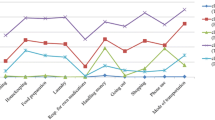Abstract
Objectives
This study aimed to determine the activity groupings reflecting functional characteristics required in daily life for the institutionalized dependent females in the old-old elderly group, by examining the interrelationships of activities based on actual achievement characteristics.
Methods
The participants were 697 dependent elderly living at welfare institutions in Japan and 344 old-old females were used for analysis. Factor analysis, based on Promax with the Kaiser Normalization method, was conducted using 74 activities of daily living (ADL) items to determine activity groups. Furthermore, whether each activity group could be classified into sub-groups was confirmed by applying factor analysis to the activities consisting of each activity group.
Results
Four activity groups of lower extremity activities, manual activities, changing and holding posture activities, and upper extremity and dexterous manual activities were interpreted. Except for the manual activity group, these activity groups were classified into two sub-groups.
Conclusions
These activity groupings were characterized by similarities of the body parts used in achievement and the difficulty of activity. The activity groupings obtained in this study are considered to be useful in ADL assessment focusing on evaluating functional characteristics of the dependent elderly.
Similar content being viewed by others
References
Tsuchiya K, Imada H, Okawa T. Activities of daily living. Ishiyaku Publishers, Inc. Tokyo, 1992, 37–52.
Kim HS, Tanaka K. The assessment of functional age using “activities of daily living” performance tests: A study of Korean women. Journal of Aging and Physical Activity 1995; 3: 39–53.
Pfeffer RI, Kurosaki TT, Harrah CH, Cance JM, Filos S. Measurement of functional activities in older adults in the community. Journal of Gerontology 1990; 37: 323–329.
Ando T. Structure analysis of ADL. In Tsuchiya K, Imada H, Okada T, eds. Activities of daily living. Ishiyaku Publishers, Inc., Tokyo, 1992, 37–52.
Demura S, Sato S, Kasuga K. The interrelationship among achievement patterns of activities of daily living for institutionalized dependent elderly. Journal of Physiological Anthropology 2002; 21: 167–175.
Spector WD, Katz S, Murphy JB, Fulton JP. The hierarchical relationship between activities of daily living and instrumental activities of daily living. Journal of Chronic Disease 1987; 40: 481–489.
Mahoney FI, Barthel WD. Functional evaluation: The Barthel Index. Maryland State Medical Journal 1965; 14: 61–65.
Shoening HA, Iversen IA. Numerical Scoring of Self-care Status: A Study of Kenny Self-care Evaluation. Archives Physical Medicine and Rehabilitation 1968; 49: 221–229.
Granger CV. Outcome of comprehensive rehabilitation: Measurement by PULSES profile and the Barthel Index. Archives Physical Medicine and Rehabilitation. 1979; 60: 145–154.
Klein MR, Bell B. Self care skills: behavioral measurement with Klein Bell ADL scale. Archives Physical Medicine and Rehabilitation 1982; 63: 335–338.
Keith RA, Granger CV, Hamilton BB, Sherwin FS. The functional independence measure: a new tool for rehabilitation. In; Eisenberg MG, Grzesiak RC, editors. Advances in clinical rehabilitation vol. 2, New York, Springer, 1987; 6–18.
Kempen GIJM, Suurmeijer JPBM. The development of a hierarchical polychotomous ADL-IADL scale for noninstitutionalized elders. Gerontologist 1990; 30: 497–502.
Sato S, Demura S, Kobayashi H, Goshi F, Minami M, Nagasawa Y, Yamaji S. Characteristics of ADL ability on partially dependent older adults: comparison among different ambulatory activities levels. Journal of physiological anthropology 1999; 18: 169–174.
Demura S, Sato S, Minami M, Kobayashi H, Noda M. The proposal of the activities of daily living (ADL) index for institutionalized older adults. Japanese Journal of Hygiene 2000; 55: 538–546. (in Japanese)
Demura S, Sato S, Mimani M, Toyoshima Y, Goshi F, Ishikawa Y. Characteristics of activities of daily living (ADL) ability in institutionalized disabled older adults: comparison according to usage conditions of assisting devices for movement. Japanese Journal of Physiological Anthropology 2000; 5: 1–8.
Kim HS, Matsuura Y, Tanaka K, Inagaki A. Factorial structure and establishment of a test battery to evaluate ability of daily living activity in the elderly. Japan. Journal of Physical Education, Health and Sport Science 1993; 38: 187–200. (in Japanese)
Author information
Authors and Affiliations
Corresponding author
Rights and permissions
About this article
Cite this article
Demura, S., Sato, S., Minami, M. et al. Activity groupings reflecting functional characteristics required in daily life in institutionalized dependent females in the old old elderly group. Environ Health Prev Med 8, 166–172 (2003). https://doi.org/10.1007/BF02897910
Received:
Accepted:
Issue Date:
DOI: https://doi.org/10.1007/BF02897910




